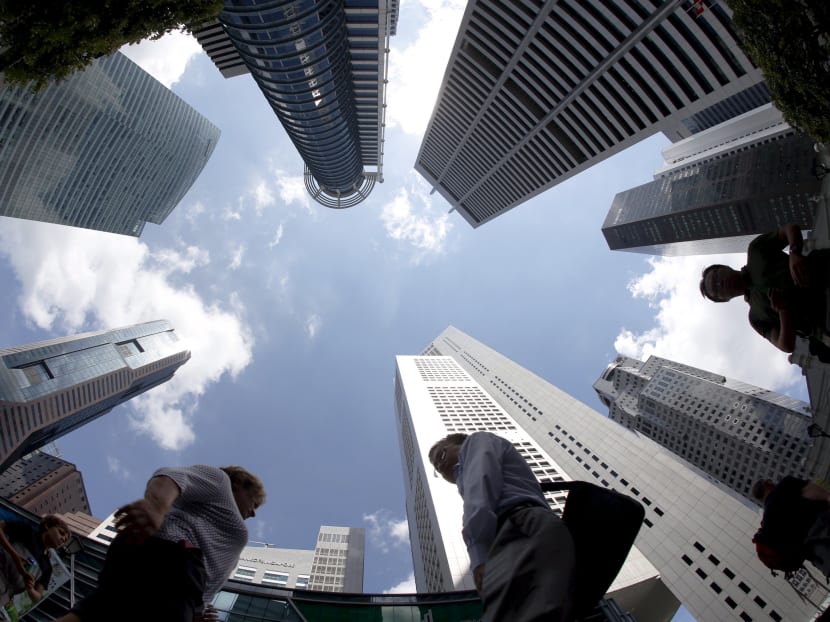In surprise move, MAS shifts to neutral stance as growth stalls
SINGAPORE — The Monetary Authority of Singapore (MAS) unexpectedly eased its policy on Thursday (April 14), guiding the Singapore dollar to a zero appreciation stance against those of its major trading partners, as growth in the first quarter stalled.

People walk past office buildings at the central business district in Singapore in this April 14, 2015 file photo. Photo: Reuters
SINGAPORE — The Monetary Authority of Singapore (MAS) unexpectedly eased its policy on Thursday (April 14), guiding the Singapore dollar to a zero appreciation stance against those of its major trading partners, as growth in the first quarter stalled.
The surprise decision drove the local currency sharply lower, and it fell 0.7 per cent to an eight-month low of RM2.8526 by the close of Asian trading. It also lost 0.7 per cent to 4.7574 yuan and shed 1 per cent to S$1.3639 versus the US dollar. Meanwhile, Singapore stocks rose, with the benchmark Straits Times Index jumping 0.8 per cent to 2,913.93, helping to boost a regional rally on hopes that more central banks will join the easing bandwagon in the coming months.
A weaker currency will help Singapore’s exports but a more sustained recovery will still depend on a rebound in global demand, economists said. Inbound tourism may also enjoy a boost while outbound Singaporeans will suffer a loss in purchasing power.
MAS stressed that its latest move is “not a policy to depreciate the domestic currency, and only removes the modest and gradual appreciation path” of the Singapore dollar nominal effective exchange rate (S$NEER) band that was in place since April 2010. It added that the width of the policy band and the level at which it is centered remain unchanged. The width of the band allows room for currency fluctuations while the level at which the band is centered reflects structural economic fundamentals.
Singapore’s economic growth was flat in the first three months of the year compared with the previous three months, slowing sharply from the 6.2 per cent expansion in the preceding quarter, advance estimates from the Ministry of Trade and Industry showed on Thursday.
“The Singapore economy is projected to expand at a more modest pace in 2016 than envisaged in the October policy review. MAS Core Inflation should also pick up more gradually over the course of 2016 than previously anticipated, and is now likely to fall below 2 per cent on average over the medium term,” the central bank said.
Most economists had expected MAS to leave its policy untouched, with 12 of 18 economists in a Bloomberg poll having forecast the central bank to stand pat. The easing was likely taken in anticipation of continued economic stagnation, Citibank analysts led by Mr Kit Wei Zheng said.
“The outlook for the global economy is seen to have dimmed since October, which poses cyclical headwinds for externally oriented sectors, with retail and real estate segments expected to soften among the domestic oriented sectors,” they noted.
Bank of Singapore’s senior currency strategist Sim Moh Siong said: “The broad tone of the policy statement is dovish, echoing downside risks to growth and inflation amid weaker external demand, and a more gradual path for core inflation due to easing labour market tightness, weaker consumer sentiment and modest energy prices... We expect the S$NEER to drift further into the weak side of the band given the downshift in Singapore’s growth outlook.”
This is the third time the MAS has eased policy in recent times. It previously announced in January and October last year that it would allow the Singapore dollar to appreciate at a slower pace against the currencies of its trading partners. Both moves last year were accompanied by changes in inflation forecast. CIMB Private Banking economist Song Seng Wun noted that the latest easing was not accompanied by adjustments to other parameters such as the growth forecast or inflation. He said it was likely a pre-emptive measure amid fears that growth may come in weaker than expected for Singapore’s trade-dependent economy.
Economists also noted that the zero appreciation, or neutral, stance was last deployed during crisis situations such as the 2008 global financial crisis and the 2001 dotcom meltdown, when growth contracted and core inflation fell into negative territory.
“The willingness of the MAS to break with tradition suggests… the current economic cycle is not a normal one – this downturn could be highly protracted,” said HSBC economist Joseph Incalcaterra.
MAS said the outlook for the global economy has dimmed, and Singapore’s major trading partners will continue to post cyclical headwinds for the external-oriented sectors here. It said the expansion of the US economy is expected to be more modest than anticipated, while economic activity in the Eurozone and Japan will be dampened by their appreciating currencies and weak external demand.
Finance Minister Heng Swee Keat also flagged external uncertainties in his Budget speech last month as he unveiled measures, including a S$4.5 billion Industry Transformation Programme, to help companies tide through challenging times and the restructuring process. - ADDITIONAL REPORTING BY ANGELA TENG






